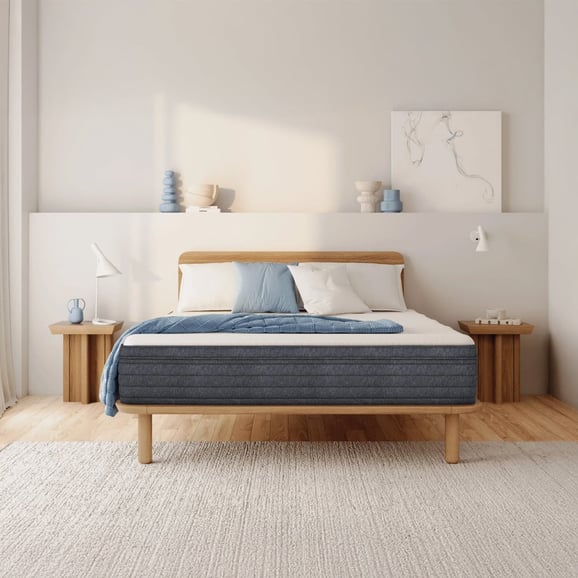Bed frames play a vital role in our daily lives by offering support, comfort, and stability while we rest. Like any other furniture item, bed frames have a specific longevity, and understanding when it’s time to purchase a new one is crucial for our overall health and well-being. This article will cover the average bed frame longevity, factors influencing it, signs indicating the need for a new bed frame, and tips for maintaining and prolonging its lifespan. Additionally, we will discuss various bed frame types and their average longevities, environmental impact and sustainability concerns, selecting the right bed frame for your requirements, budgeting for a new bed frame, and responsibly discarding your old bed frame.
Typical bed frame longevity
On average, a bed frame lasts between seven and 15 years, with ten years being a general guideline for the usual longevity. However, this may vary based on factors like the frame’s type and quality, its usage, and maintenance levels. It’s crucial to be aware of these factors and monitor your bed frame for wear and tear signs, ensuring you replace it when needed, which helps maintain a healthy and comfortable sleeping environment.
It’s worth noting that the mattress’s lifespan can also impact the bed frame’s longevity. A worn-out mattress might cause additional stress on the bed frame, resulting in a shorter overall lifespan. As a general rule, consider replacing your bed frame when you invest in a new mattress or when you notice signs that it’s time for a new one.
Influencing factors for bed frame longevity
Several factors can influence a bed frame’s lifespan, including:
Material and construction: High-quality materials and robust construction generally result in a longer-lasting bed frame. Solid wood and metal frames tend to have longer longevities compared to particleboard or MDF alternatives.
Usage and care: The way you use and care for your bed frame can also affect its lifespan. Regularly overloading the bed frame with excessive weight or frequently moving it can cause unnecessary wear and tear, shortening its lifespan.
Maintenance and repairs: Inspecting your bed frame regularly for signs of damage and performing necessary repairs can help prolong its lifespan. Tightening loose screws and bolts, and replacing worn or damaged parts can prevent further wear and tear, extending the bed frame’s longevity.
Indicators for a new bed frame
Recognizing when it’s time to invest in a new bed frame is essential for maintaining a comfortable and supportive sleep environment. Some signs that it might be time for a new bed frame include:
Squeaking or creaking sounds: If your bed frame makes excessive noise when you move or shift your weight, it might indicate that it’s no longer providing adequate support.
Visible sagging or damage: Inspect your bed frame for visible wear and tear signs, such as sagging or broken slats, cracked or split wood, or damaged metal components. If you notice any of these issues, it’s likely time for a replacement.
Unstable or wobbly: A bed frame that feels unstable or wobbles when you move may no longer provide the support you need for a comfortable night’s sleep.
Discomfort or poor sleep quality: If you experience discomfort or poor sleep quality and have ruled out other factors like your mattress or bedding, it might indicate that your bed frame is no longer providing the necessary support.
Guidelines for maintaining and prolonging bed frame longevity
To maximise your bed frame’s lifespan, consider the following guidelines:
Adhere to assembly instructions: Assembling your bed frame correctly according to the manufacturer’s instructions ensures it’s structurally sound and less likely to experience premature wear and tear
Regular inspection and hardware tightening: Check for loose screws, bolts, or other hardware and tighten them as needed to maintain your bed frame’s stability
Avoid excessive weight or movement: Refrain from overloading your bed frame with excessive weight and avoid jumping or bouncing on it, as this can cause unnecessary stress and damage.
Clean and protect the frame: Keep your bed frame clean and dust-free, and protect it from moisture or other environmental factors that could cause damage or wear.
Rotate and flip your mattress: Regularly rotating and flipping your mattress can help distribute wear evenly, reducing stress on the bed frame and extending its lifespan.
Final thoughts
Understanding the lifespan of a bed frame and recognizing when it’s time to invest in a new one is crucial for maintaining a healthy and comfortable sleep environment. By considering factors such as material and construction, usage and care, and maintenance and repairs, we can extend the lifespan of our bed frames and get the most out of our investment. As you choose a new bed frame, remember to prioritize environmental impact and sustainability, as well as factors like size, style, budget, and ease of maintenance. By disposing of your old bed frame responsibly and choosing a new one that meets your needs, you can ensure a supportive and comfortable sleep environment for years to come.














